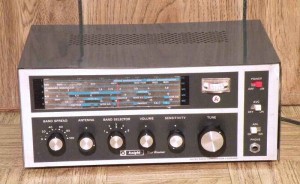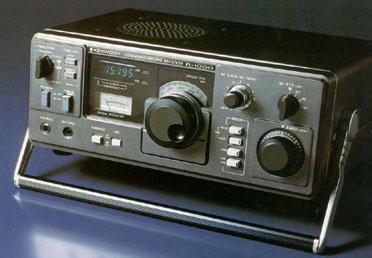Harold Woering ’s radio story is the latest in our series called Listener Posts, where I will place all of your personal radio histories. If you would like to add your story to the mix, simply send your story by email!
In the meantime, many thanks to Harold for sharing his personal radio history:
Harold Woering (N1FTP), WDX1IGG, HFU-Dutch Master, and WPC1HJW
 My shortwave experience started in 1967 at the age of 13. My father brought home these old AM/FM/SW tube radios probably dating back to the 30’s and 40’s and asked if I wanted them. That’s all it took and my first QSL is dated May 20, 1967 from Radio Cairo, Egypt. I found out from my cousin that if you wrote the station a letter telling them what you heard, that they would send back a verification in the form of a card, pennant, or letter. Today my count for unique verifications is well over 500 with numerous “goodies” that I have received over the years.
My shortwave experience started in 1967 at the age of 13. My father brought home these old AM/FM/SW tube radios probably dating back to the 30’s and 40’s and asked if I wanted them. That’s all it took and my first QSL is dated May 20, 1967 from Radio Cairo, Egypt. I found out from my cousin that if you wrote the station a letter telling them what you heard, that they would send back a verification in the form of a card, pennant, or letter. Today my count for unique verifications is well over 500 with numerous “goodies” that I have received over the years.
My first purchased shortwave receiver was a Knight Kit Star Roamer in 1969. From there it was the Heathkit GR-64 in 1972 and the Realistic DX-160 in 1985. From 1985 to 1990 I was the awards chairman for SPEEDX (The Society to Preserve the Engrossing Enjoyment of DX’ing).
I was beside myself when I bought my first digital readout radio, the Kenwood R-1000 in 1987. No more guessing as to what frequency I was listening to. That was also the year I ended up as station of the month in Popular Communications magazine. Currently I use an Icom R71a and a Sangean ATS 818ACS and a 450 foot horizontal loop antenna. I have a lot of great memories and still enjoy the hobby immensely. Many of the Big stations are gone but that has had room for many of the smaller ones. I continue to listen almost daily and still enjoy the hobby.
Many thanks, Harold, for sharing your story!
Click here to read our growing collection of Listener Posts, and consider submitting your own!


I went over to Harold’s house one time to look at a portable SW radio he was selling. He showed me the Kenwood R1000 and it sure sounded good on the AM mode. That was back around the early to mid 1980’s and then we used to talk on 50.400 AM phone for a year or two after that. Jim WA1EDN
“Kids today don’t know how easy they have it”.
I remember writing “it’s closer to the .5 mark than an even number” and even that wasn’t accurate since the Hallicrafters S-120A had pretty much no calibration, even on the MHz marks, and the actual pointer on the slide rule dial was about 1/8 inch wide.
When I started reading the magazines, frequency counters were just starting to become cheap and simple enough for the average hobbyist to consider. Heathkit had its first digital frequency counter out in 1971, and the magazines were full of frequency counter articles.
I’m not sure I saw a a picture of a receiver with digital readout until 1972, Communicaton World and the like showing off some really high end receivers that we could only drool about. There was the Collins R390, a mechanical digital readout, but even as surplus those were pretty expensive.
So most of the first wave of receivers with frequency counters were when someone added an external counter to an existing receiver. Those varied, the simplest was to just read the local oscillator frequency, and then add in the IF frequency. But then you could mix the various oscillators together and read that frequency (which would be the signal frequency, but more work) or later frequency counters that allowed one to program an offset, to compensate for the frequency of the IF.
The simplest arrangement was for receivers that tuned a fixed 500KHz or so range on each band, a crystal controlled converter ahead of that fixed tuned receiver. There you’d just read the VFO frequency and hope the crystals were on frequency. Of course, that sort of receiver had better calibration, since it only needed to be done for one range, and a limited range at that.
And few such receivers were used in shortwave listening, since you needed a crystal for each 500KHz segment. That’s when synthesizers arrived, the HRO-500 in the early sixties, just synthesizing a frequency every 500KHz, relatively easy. So you could build one, and use it to get more range on something like the Drake SPR-4, that came with a limited number of crystals.
Or the Wadley loop, a different arrangement but in effect a way of synthesizing a crystal every 500KHz. As seen in a late fifties Racal, but also in the famous Barlow Wadley portable receiver in the early seventies, probably the first portable to use a fixed tuning range (so the acuracy of the dial was better than any previous portable sw receiver.
For most people, an actual synthesized tuning receiver didn’t arrive till the Sony 2001 in the early eighties. They existed, just way too expensive.
One can now pay a hundred dollars for a new shortwave receiver, and at least tuning wise, it beats just about any shortwave receiver from forty years ago. Other problems exist, including fewer shortwave broadcast stations, but at least one knows the frequency.
Michael